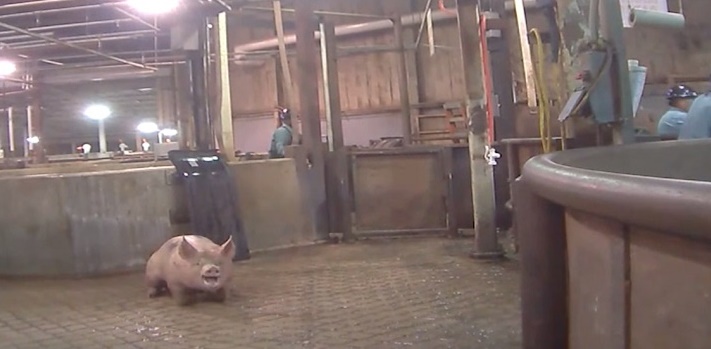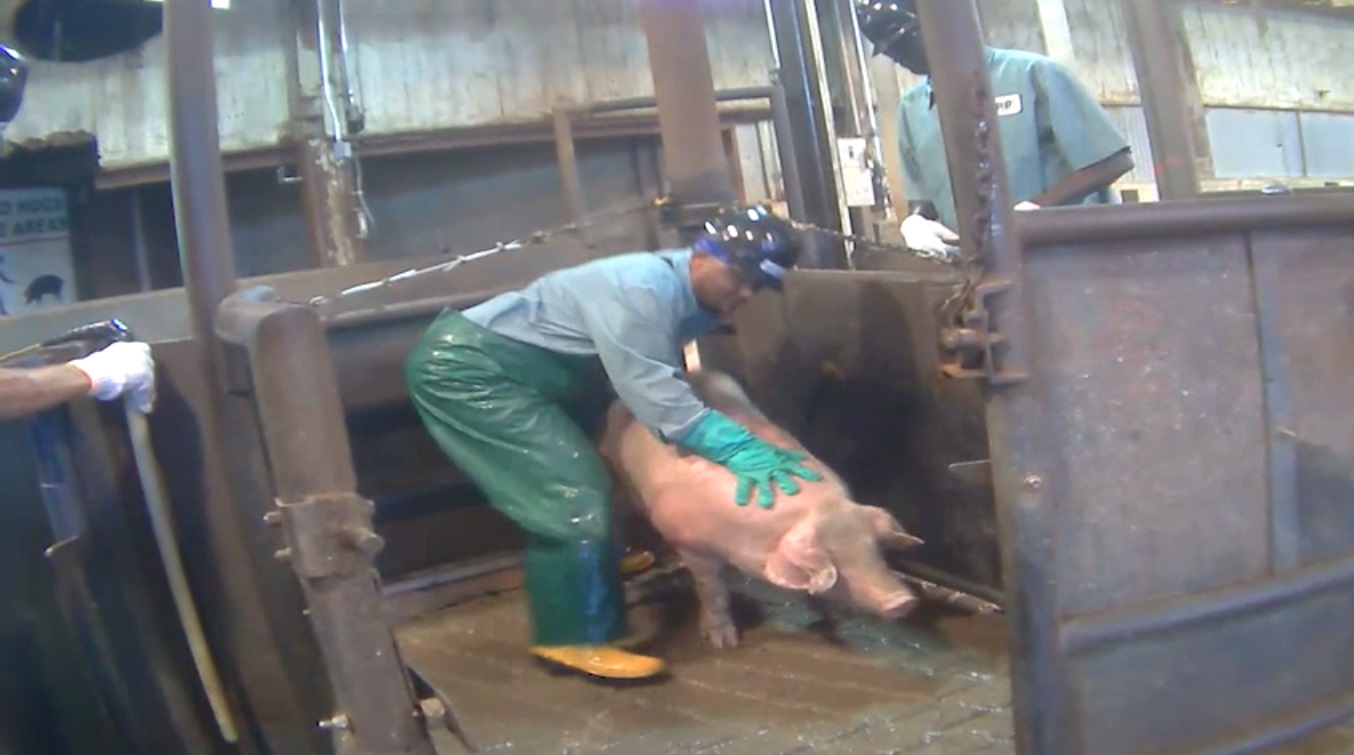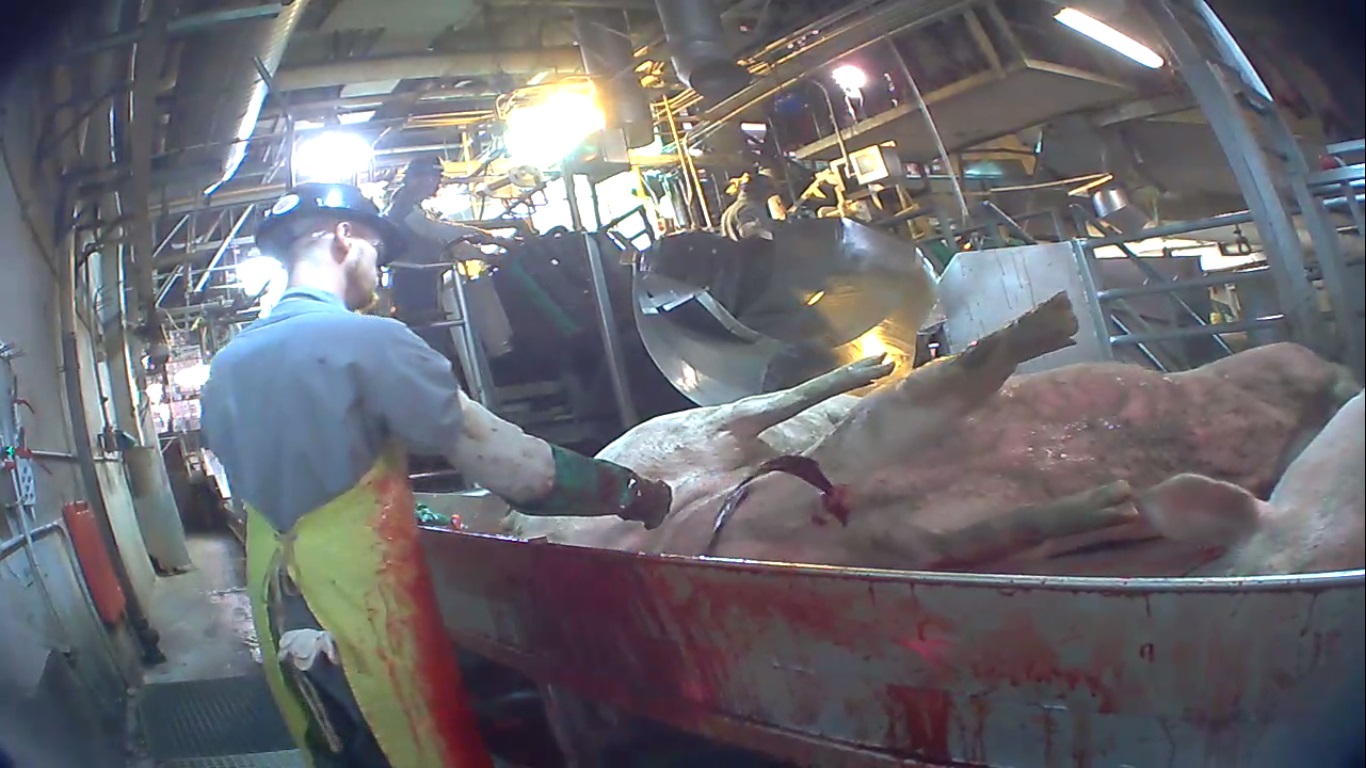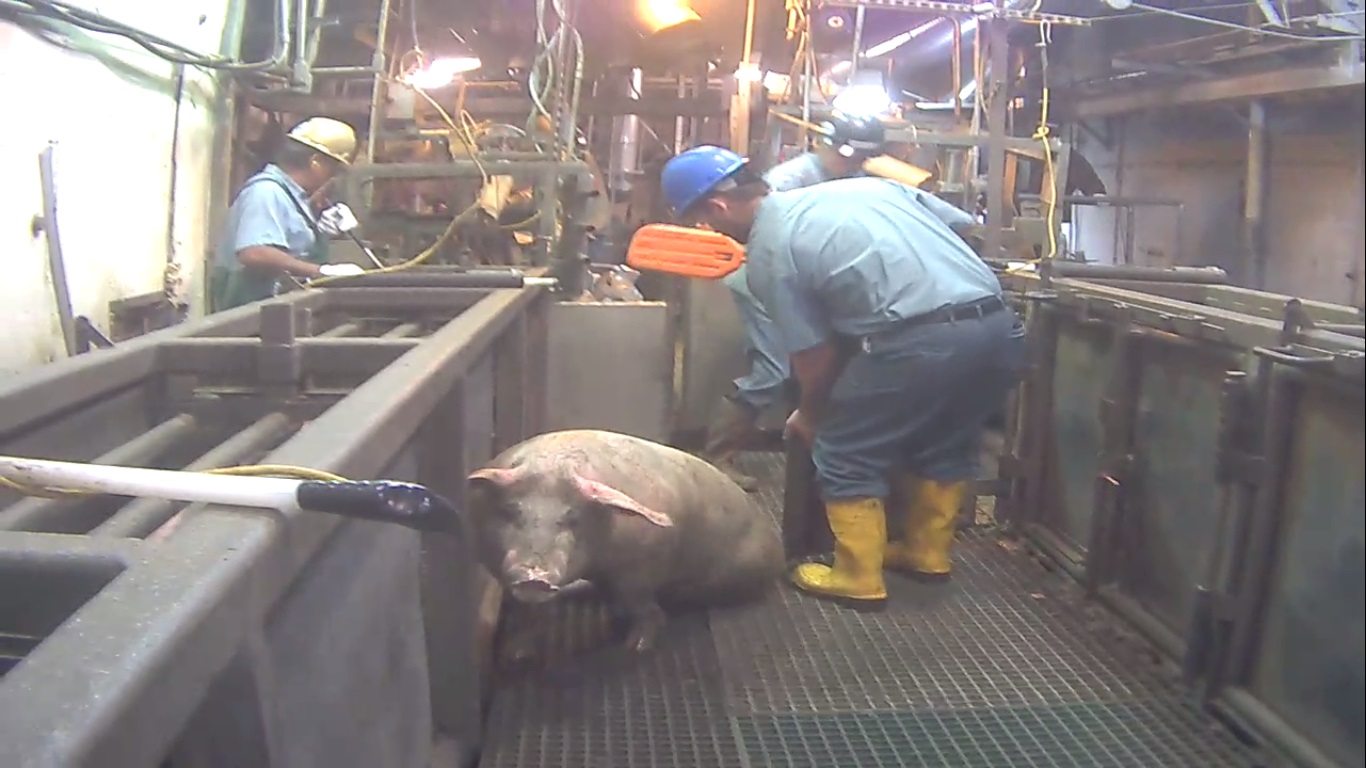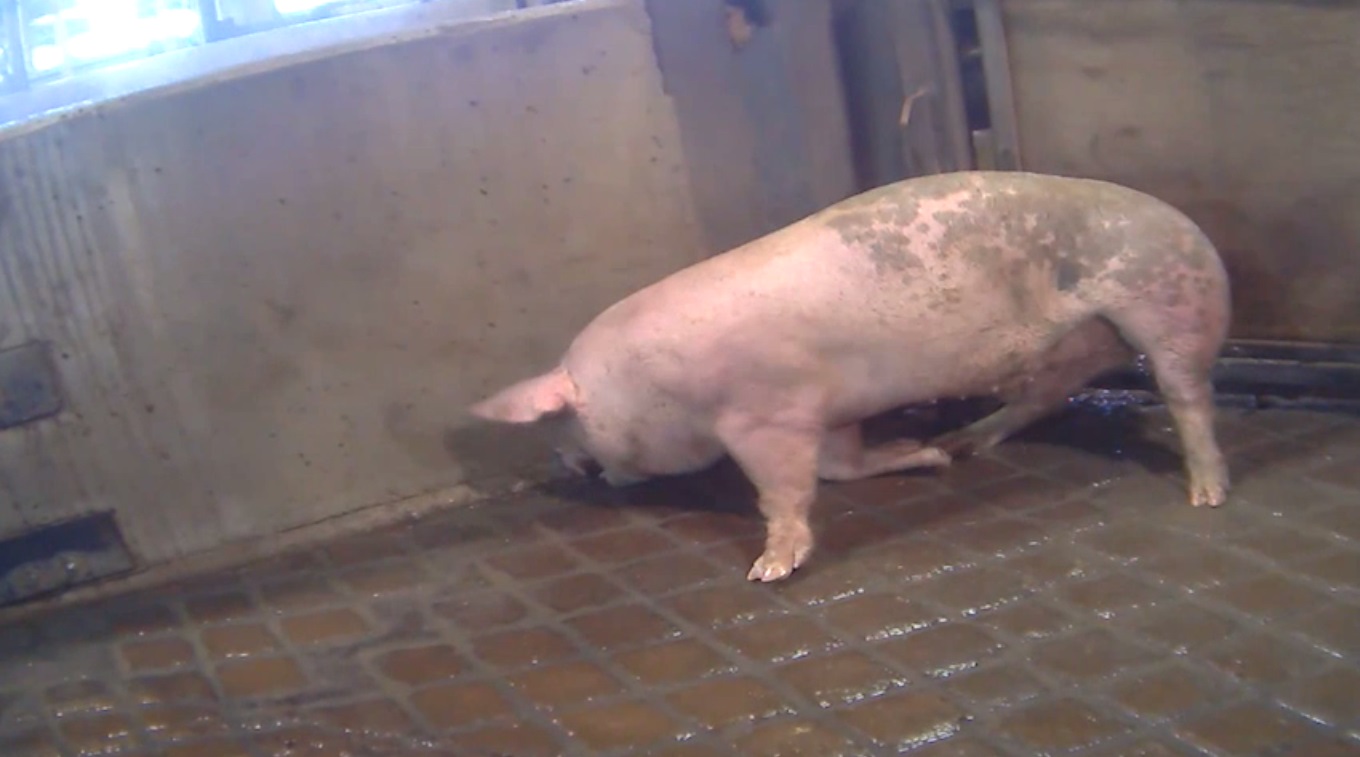In 2015, an Animal Outlook investigator worked inside Quality Pork Processors (QPP), a USDA-inspected slaughterhouse in Minnesota that exclusively supplies to Hormel, the makers of SPAM.
This shocking footage offers a disturbing, close-up view of the suffering endured by pigs as they are pushed, prodded and dragged to their death.
At the time of our investigation, this facility was one of five (as of 2021, there are nine) pig slaughterhouses in the U.S. operating under a USDA pilot program, known as “HIMP,” that allows for high-speed slaughter of pigs and reduced government oversight. That means this facility operates at faster line speeds than almost any other facility in the U.S.: approximately 1,300 pigs are killed each hour, their meat to be sold as SPAM or other Hormel pork products.
The excessive slaughter line speed forces workers to take inhumane shortcuts that lead to extreme suffering for millions of pigs. It also jeopardizes food safety for consumers.
Our video inside this Hormel supplier documents:
- animals being beaten, shocked, dragged, and improperly stunned—all out of view of the few government inspectors
- sick and injured pigs unable to walk, known as “downers,” enduring particularly egregious abuses, since they
 cannot walk to the kill floor
cannot walk to the kill floor - pigs covered in feces or pus-filled abscesses being slaughtered and processed for human consumption with a USDA inspection seal of approval
- numerous instances of improper stunning and slaughter, potentially leading to some animals entering the scalding tank while still alive
- a supervisor sleeping on the job when he should have been overseeing the stunning process to ensure workers were following protocol
By allowing facilities like QPP to operate at increased slaughter speeds combined with reduced oversight, the USDA essentially gives the profit-driven pork industry a free pass to police itself -- producing devastating consequences for animals, workers and consumers.
A 2013 Office of Inspector General Audit Report clearly identifies several concerns about the HIMP pilot program, including food safety and humane animal handling. Last year, several USDA whistleblowers also spoke out about the dangers of this high-speed, reduced-inspection program.
HIMP has been in place for over 10 years, yet the USDA has not yet thoroughly reviewed the program to determine its effectiveness. That announcement is expected in early 2016.
“…if the USDA is around, they could shut us down…”
- QPP employee
Hormel Investigation Photos
Hormel & HIMP
Hormel is one of the top pork producers in the U.S., best known as the makers of SPAM.
The Minnesota-based company sits just down the street from Quality Pork Processors (QPP), the pig slaughter plant where our investigator worked while wearing a hidden camera to document the miseries forced upon pigs during the last few moments of their lives. QPP is an exclusive Hormel supplier.
Although the company makes claims like “For more than 120 years, Hormel Foods has focused on treating animals humanely, simply because it’s the right thing to do,” this is not the first time that an Animal Outlook investigation has uncovered inhumane treatment of animals at a facility associated with Hormel. See our video inside a pig breeding factory farm in Iowa.
Animal Outlook’s new exposé uncovers more of Hormel’s hidden horrors: High-speed slaughter hell.
What is HIMP?
For starters, HIMP is an acronym (within an acronym) that stands for “Hazard Analysis and Critical Control Point (HACCP) Based Inspection Models Project.”
This USDA pilot program, created more than 10 years ago, supposedly aims to “yield improved food-safety and other benefits to consumers.” In practice, this program reduces the number of government-trained inspectors at slaughter plants. It shifts much of the inspection and food safety control measures into the hands of the slaughter plants themselves and allows facilities to run slaughter lines at higher speeds than other plants where full government inspection still takes place.
There are currently five pig slaughter facilities operating under this USDA high-speed, reduced-inspection pilot program. Quality Pork Processors in one of them—and Hormel is associated two of the other four.
Although HIMP officially launched more than 10 years ago, the USDA has yet to thoroughly review the program to determine its efficacy and safety. It’s expected that the USDA will announce its findings in early 2016—and it may decide to expand this dangerous program to hundreds of other USDA-inspected pig slaughter plants nationwide. This program is so dangerous that several USDA whistleblowers have spoken out against it—and a government audit report echoes these concerns.
By transferring many of the inspection responsibilities from trained government employees to the companies themselves, the protection of consumers, workers, and animals are put at risk. There is a fundamental flaw in expecting companies with a financial interest in processing as many animals as possible as quickly as possible to adequately police themselves.
In 2013, an audit report issued by the USDA’s Office of Inspector General (OIG) underscored many of these deeply troubling concerns. The report notes the inadequate oversight of the Food Safety and Inspection Service (FSIS), the USDA’s inspection arm. According to the report:
“Since FSIS did not provide adequate oversight, HIMP plants may have a higher potential for food safety risks.”
“Although HIMP was intended to improve food safety, we found that 3 of the 10 plants cited with the most NRs [Non-compliance reports] from FY 2008 to 2011 were HIMP plants. In fact, the swine plant with the most NRs during this timeframe was a HIMP plant — with nearly 50 percent more NRs than the plant with the next highest number.”
In conclusion, “[T]he swine HIMP program has shown no measurable improvement to the inspection process; the program was not studied during its first 15 years; three of five HIMP plants had some of the highest numbers of NRs nationwide; and one plant was allowed to forgo an essential food safety procedure.”
“The actions depicted in the video under review are appalling and completely unacceptable.”
- USDA
Press
Coverage of Animal Outlook's legal complaint filed against QPP (Dec 2016):
- Courthouse News Service: Animal Lovers Decry 'Sadistic' Treatment of Pigs
- Consumer Affairs: Lawsuit charges Minnesota slaughterhouse abuses pigs
- City Pages: Quality Pork Processors sued for cruelty after officials fail to act
- Care2: Animal Advocates Take Action on Slaughterhouse Cruelty When USDA Won't
Investigation coverage:
- Washington Post: “That one was definitely alive”: An undercover video at one of the nation’s biggest pork processors
- Wall Street Journal: “Animal-Rights Group Says Video Shows Abused Pigs at Hormel Supplier”
- Minneapolis Star-Tribune: “USDA investigating Hormel supplier's treatment of pigs after video surfaces”
- Associated Press: “Undercover video shows 'extreme suffering' at Hormel supplier”
- Reuters: “USDA probes animal abuse video at Hormel pork supplier QPP”
- UPI: “USDA investigates undercover animal abuse video at Hormel slaughterhouse”
- The Daily Mail (UK): “That one was definitely alive': Horrific undercover factory video shows pigs shaking in pain as they are killed in Minnesota slaughterhouse after being beaten”
- ABC 6 News: Animal rights nonprofit pushing USDA to investigate Austin processing plant"
- Minnesota Public Radio: “Group unveils undercover video from Minnesota slaughterhouse”
- Huffington Post: “Undercover Video Appears To Show Pigs Conscious, Shaking In Pain As They Face Slaughterhouse Death”
- Mother Jones: “There's a Horrifying Pork Factory Video Going Around. The Story Behind It Is Even Worse.”
- RT News: “Undercover video shows pig maltreatment at major US pork supplier plant”
- ABC 6 News: “QPP, Hormel Foods Respond to Undercover Slaughter Video”
- Times Gazette: “Pigs ill treated at Minnesota slaughter house – undercover video exposes abuse at Hormel supplier”
- StarMine News: “Hormel Foods Supplier Under Fire on on Animal Rights, Sanitation Violations”
- Meatingplace: “Latest undercover plant video spotlights Hormel pork supplier”
- Minneapolis City Pages: "Disgusting Hormel slaughterhouse footage could turn you off bacon"
- Tech Times: "Tortured Bacon is Not Good: USDA investigates animal abuse video at Hormel Pork Supplier QPP"
- Times Gazette: "Pigs ill treated at Minnesota slaughter house - undercover video exposes abuse at Hormel supplier"
- Epoch Times: "Undercover video after months of work at huge pork processor sparks government investigation"
- Minneapolis Business Journal: "Hormel supplier gets scrutiny over undercover video in pork plant
- Inquistr: "USDA faces widespread criticism after horrifying undercover video of Hormel pork processing plant surfaces online"
- Sud Press (Belgium): "Des images choquantes filmées dans un abattoir où les cochons sont battus et traînés conscients avec des crochets"
- NY Daily News: "Shocking video shows pigs shaking in fear, being beaten at Minn. slaughterhouse"
- Christian Science Monitor: "Video reveals 'completely unacceptable' treatment of pigs by Hormel supplier"
- The Daily Star (UK): "WATCH: Horrifying moment slaughterhouse workers brutally abuse innocent pigs"
- DS De Standaard (Belgium): "Afschuwelijke beelden tonen dierenmishandeling in Amerikaanse varkensslachterij"
- Mundo a o Minuto (Portugal): "Vídeo revela abusos e condições grotescas em matadouro americano"
- Mic.com: "Undercover Slaughterhouse Footage Shows Horrific Animal Abuse"
- Austin Daily Herald: "Animal rights investigator says issues stem from push for speed"
- Al Jazeera Video: "Undercover Video Reveals Horrifying Animal Abuse"
- NowThis News: "Horrifying video of extreme animal abuse was taken at a major pork distributor"
- The Young Turks Network: "Disgusting Leaked Footage Of Pig Farm"
- India.com: "Shocking! Pigs tortured at slaughterhouse"
- Food Safety News: "Retired USDA Inspectors share concern about HIMP project"
- Tabo-Labo.com: "【閲覧注意】 隠し撮りで明らかになった、豚肉処理現場のリアル"
- New York Times Magazine: The Fight Over Transparency in the Meat Industry
Act Now
You Can Help Stand Up for Pigs and All Animals!
Sadly, animal abuse is standard practice throughout the meat industry, though therecute-pigs-closeup are simple steps each of us can take to make a difference for animals.
Here’s how you can get started:

